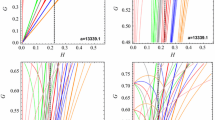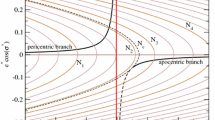Abstract
The Ideal Resonance Problem, defined by the Hamiltonian
has been solved in Garfinkelet al. (1971). As a perturbed simple pendulum, this solution furnishes a convenient and accurate reference orbit for the study of resonance. In order to preserve the penduloid character of the motion, the solution is subject to thenormality condition, which boundsAB" andB' away from zero indeep and inshallow resonance, respectively. For a first-order solution, the paper derives the normality condition in the form
Herep i are known functions of the constant ‘mean element’y', α is the resonance parameter defined by
and
defines the conventionaldemarcation point separating the deep and the shallow resonance regions. The results are applied to the problem of the critical inclination of a satellite of an oblate planet. There the normality condition takes the form
withΛ 1, andΛ 2 known functions of λ, defined by
Similar content being viewed by others
References
Aoki, S.: 1963,Astron. J. 68, 355.
Breakwell, J.: 1961, Private communication.
Brouwer, D. and Clemence, G. M.: 1961,Planets and Satellites, (ed. by G. H. Kuiper), Univ. of Chicago Press, pp. 72–73.
Brown, E. W. and Shook, C. A.: 1933,Planetary Theory, Dover Publ. Co., New York, Ch. VIII.
Garfinkel, B.: 1962,Proceedings of the First International Symposium on the Use of Artificial Satellites in Geodesy, Washington, D.C.,-abstract only.
Garfinkel, B.: 1966,Astron. J. 71, 657 (Paper I).
Garfinkel, B.: 1970,Periodic Orbits, Stability, and Resonance, (ed. by G. E. O. Giacaglia), Reidel Publ. Co., p. 474.
Garfinkel, B.: 1972a,Celest. Mech. 5, 189 (Paper III).
Garfinkel, B.: 1972b,5, 451 (Paper IV).
Garfinkel, B., Jupp, A., and Williams, C.: 1971,Astron. J. 76, 157 (Paper II).
Hori, G.: 1960,Astron. J. 65, 291.
Izsak, I.: 1962,S.A.O., Special Report 90.
Jupp, A. H.: 1969,Astron. J. 74, 35.
Jupp, A. H.: 1970,Monthly Notices Roy. Astron. Soc. 148, 197.
Tisserand, F. F.: 1889–1896,Méchanique Céleste, Gauthier-Villars, Paris, v.IV, p. 421ff.
von Zeipel, H.: 1916,Arkiv. Mat. Astron. Fys. II.
Whittaker, E. T. and Watson, G. N.: 1965,A Course in Modern Analysis, Cambridge University Press, Ch. XXII.
Author information
Authors and Affiliations
Rights and permissions
About this article
Cite this article
Garfinkel, B. Normality condition in the ideal resonance problem. Celestial Mechanics 6, 151–166 (1972). https://doi.org/10.1007/BF01227778
Received:
Issue Date:
DOI: https://doi.org/10.1007/BF01227778




